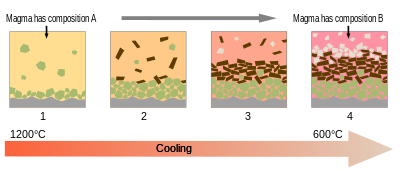Fractional crystallization (geology)

Fractional crystallization, or crystal fractionation, is one of the most important geochemical and physical processes operating within
Igneous rocks
Fractional crystallization is the removal and segregation from a melt of mineral precipitates; except in special cases, removal of the crystals changes the composition of the magma.[2] In essence, fractional crystallization is the removal of early formed crystals from an originally homogeneous magma (for example, by gravity settling) so that these crystals are prevented from further reaction with the residual melt.[3] The composition of the remaining melt becomes relatively depleted in some components and enriched in others, resulting in the precipitation of a sequence of different minerals.[4]
Fractional crystallization in silicate melts (
Experiments have provided many examples of the complexities that control which mineral is crystallized first as the melt cools down past the
One example concerns crystallization of melts that form
Granitic magmas provide additional examples of how melts of generally similar composition and temperature, but at different pressure, may crystallize different minerals. Pressure determines the maximum water content of a magma of granite composition. High-temperature fractional crystallization of relatively water-poor granite magmas may produce single-alkali-feldspar granite, and lower-temperature crystallization of relatively water-rich magma may produce two-feldspar granite.[13]
During the process of fractional crystallization, melts become enriched in
Sedimentary rocks
Fractional crystallization is important in the formation of sedimentary evaporite rocks.[20]
See also
- Cumulate rock – Igneous rocks formed by the accumulation of crystals from a magma either by settling or floating.
- Flow banding – Bands or layers that can sometimes be seen in rock that formed from magma
- Fractional crystallization (chemistry) – Method for refining substances based on differences in their solubility
- Igneous differentiation – Geologic process in formation of some igneous rocks
- Layered intrusion – large sill-like body of igneous rock
References
- ^ Petrology The Study of Igneous...Rocks, Loren A. Raymond, 1995, McGraw-Hill, p. 91
- ISBN 9780412533105.
- ISSN 0026-461X.
- ^ Petrology The Study of Igneous...Rocks, Loren A. Raymond, 1995, McGraw-Hill, p. 65
- ^ Lange, R.L.; Carmichael, Ian S.E. (1990). "Thermodynamic properties of silicate liquids with emphasis on density, thermal expansion and compressibility". Reviews in Mineralogy and Geochemistry. 24 (1): 25–64. Retrieved 8 November 2020.
- S2CID 129917491.
- ISBN 9780521880060.
- ISBN 0877353239.
- .
- ^ Philpotts & Ague 2009, pp. 609–611.
- ^ Philpotts & Ague 2009, pp. 201–205.
- ^ Kushiro, Ikuo (1969). "The system forsterite-diopside-silica with and without water at high pressures" (PDF). American Journal of Science. 267.A: 269–294. Retrieved 8 November 2020.
- ^ McBirney 1984, pp. 347–348.
- ISBN 0-08-044847-X.
- ^ Bowen, N.L. (1956). The Evolution of the Igneous Rocks. Canada: Dover. pp. 60–62.
- ^ McBirney 1984, pp. 68–102.
- ^ Philpotts & Ague 2009, pp. 194–240.
- ^ Philpotts & Ague 2009, pp. 239–240.
- .
- .

